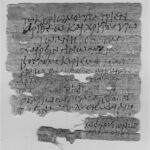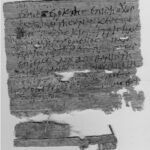| Artefact ID | 156 |
| TM ID | TM 129871 |
| Findspot (DEChriM ID) | 58 (Dayr al-ʿIẓām) | Class | Textual |
| Material | Papyrus |
| Writing medium | Sheet/roll |
| Text content | Documentary |
| Language | Greek |
| Archive/Dossier | Archive |
| Description | Gonis 2008: 73-77, no. 1; P.Misc.inv. II 70: Letter from Epagathos to Apa John. Epagathos, who is in prison, writes this badly spelled letter to "[his] lord father, in Lord God, and son of Christ, Ioannes", asking him to mediate with a certain Apollonios and secure his release. He bemoans the lack of food and his hunger, and says that he puts all his trust in God and Apa Ioannes. The editor notes a reference to the “love of God” (l. 18: dia tên agapên tou theou) which is common in patristic literature but not in the papyri. The text runs across the fibres on the front, and continues, on to the back along the fibres. Traces of earlier writing on the back. No address. The Apa John of this archive was identified with the famous John of Lykopolis known by literary sources by Zuckerman 1995. Most of the Greek and Coptic letters of this archive are addressed by monks, clerics, soldiers, state officials and individuals to Apa John, so that he would intercede in their favour in dealings with the authorities or pray for them. |
| Selection criteria | Mention of Christian individuals/communities, Christian terms/formulas/concepts |
| Date from | 375 |
| Date to | 399 |
| Dating criteria | Palaeography and archive connection (Gonis 2008: 69-72) |
| Absolute/relative date | Relative date |
| Archaeological context | According to Constantine Zuckerman's reconstruction, the Apa John’s letters were presumably found in September 1897, during the excavations of Farag Ismael and Yassa Tadros on the mountain of Siout (Lykopolis), in the ruins of Dayr al-'Azam, the site of the monastery of John of Lycopolis. Yet they never reached the museum in Gizeh – like the other objects unearthed during these excavations – and must have ended on the market, where they were bought soon after the excavations (Zuckerman 1995: 191-192; Van Minnen 1994: 80-82, Gonis 2008: 69-72). Although not proven, this attractive hypothesis is generally accepted by scholars (see discussion in Van der Vliet 2015: 166-167, and some reservations in Choat 2017: 37-40). |
| Accession number | Oxford, Sackler Library, Papyrology Rooms EES, P. Misc. inv. II 70 |


 Json data
Json data





